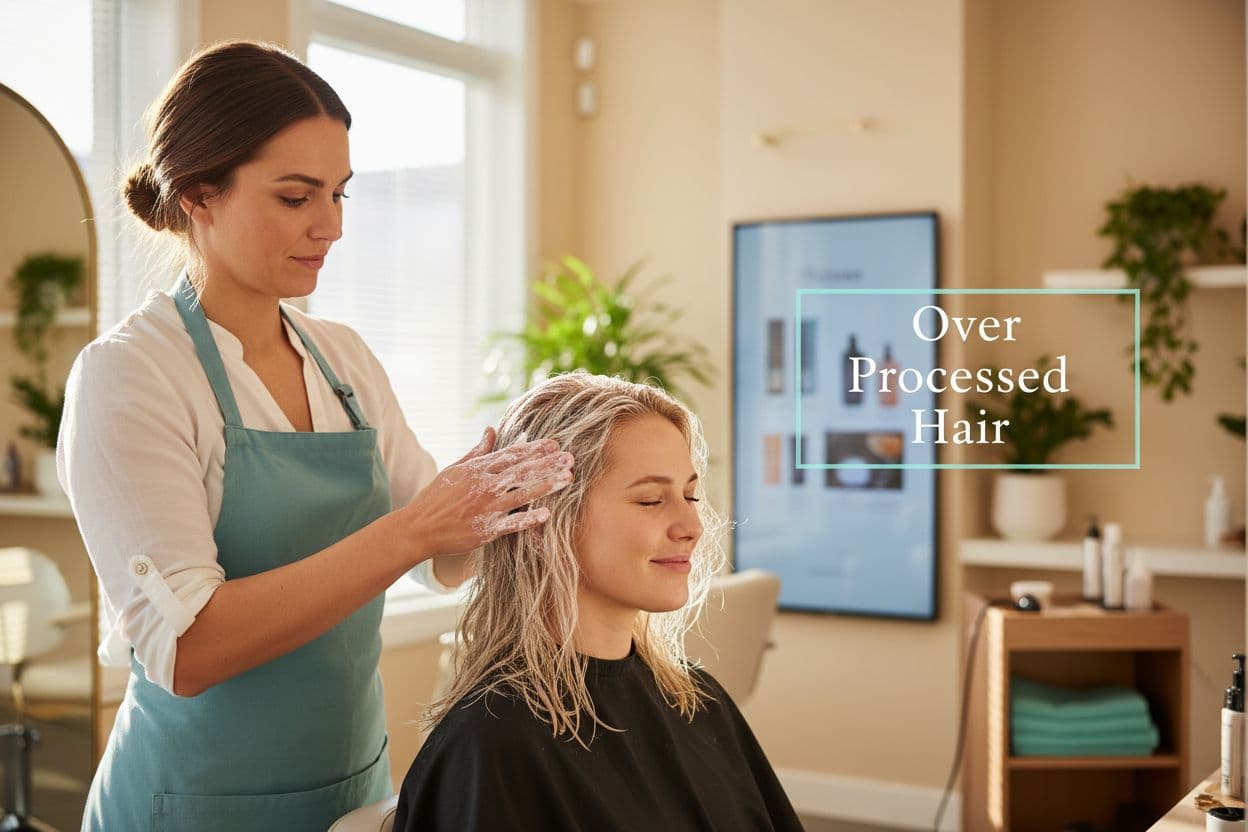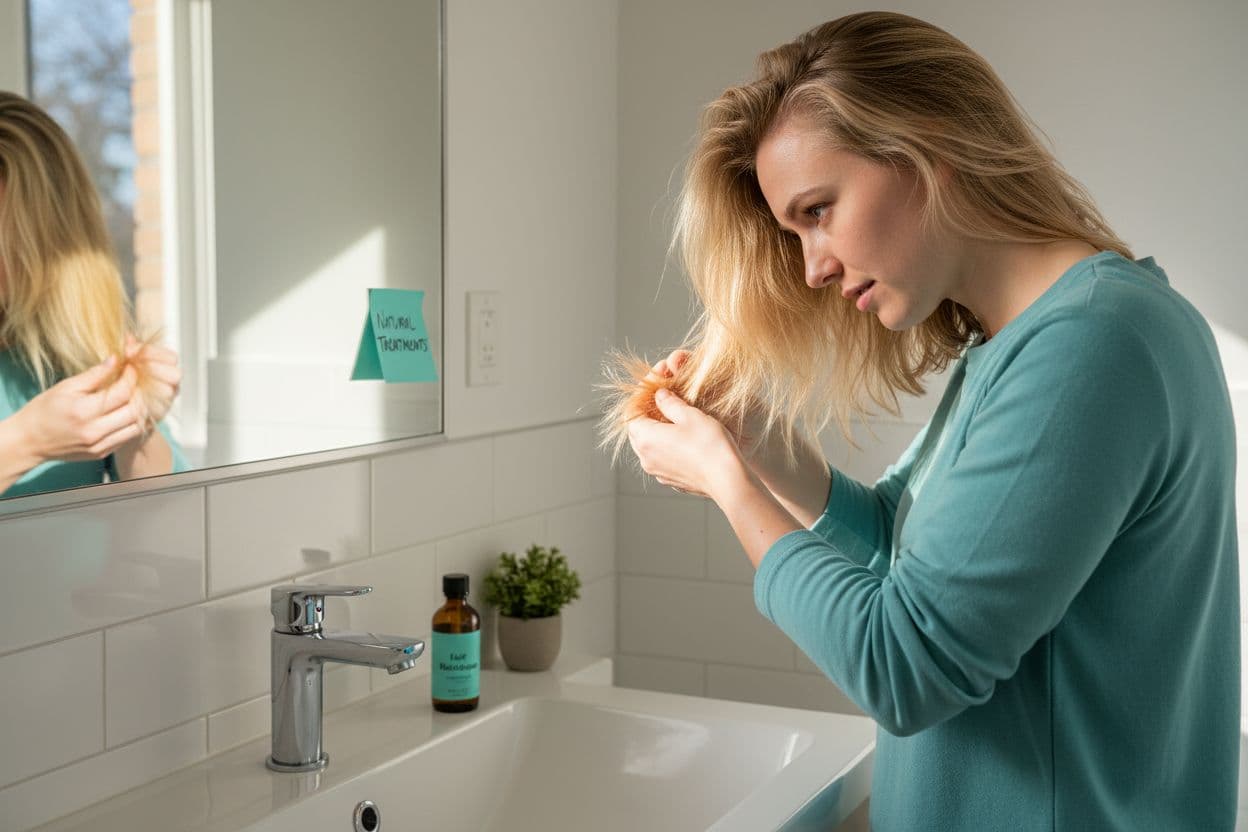Blog
Learning Materials
Understanding Treatment for Over Processed Hair: Key Insights
Updated: October 6, 2025

Over processed hair can leave even the healthiest strands looking fried and lifeless. Research shows that repeated chemical treatments can destroy up to 30 percent of hair’s natural protein structure with just a few salon visits. Most people expect colored or straightened hair to bounce right back with a little conditioner. The real surprise is how fast and how deep the damage can go before you even notice.
Table of Contents
- What Is Over Processed Hair And Why Does It Occur?
- The Impact Of Chemical Treatments On Hair Health
- Understanding Hair Structure And Damage Recovery
- Natural Treatments And Remedies For Hair Restoration
- Preventive Measures For Maintaining Healthy Hair
Quick Summary
| Takeaway | Explanation |
|---|---|
| Avoid excessive chemical treatments | Limiting chemical processes helps maintain hair integrity and avoid irreversible damage. |
| Recognize signs of over processed hair | Indicators include extreme dryness, brittleness, and frequent breakage. |
| Utilize natural oils for restoration | Oils like coconut and argan replenish lost lipids and protect hair structure. |
| Implement protective hair care techniques | Use gentle styling methods and protective accessories to minimize damage. |
| Consult professionals for treatment moderation | Seek expert advice to assess hair condition and recommend safe treatment intervals. |
What is Over Processed Hair and Why Does It Occur?
Over processed hair represents a significant challenge in hair care, characterized by severe structural damage resulting from repeated chemical treatments. Research from the National Institutes of Health reveals that chemical processes fundamentally alter hair's protein structure, leading to profound physical and aesthetic changes.
The Chemical Transformation Process
Chemical treatments like bleaching, coloring, perming, and straightening disrupt hair's natural protective layer called the cuticle. When these treatments are performed excessively or improperly, they cause irreversible damage. The process involves breaking down hair's protein bonds, which makes hair more vulnerable to environmental stressors and mechanical damage.
Key chemical interactions that contribute to over processing include:
- Permanent alteration of hair's keratin protein structure
- Extensive removal of natural protective lipids
- Weakening of internal hair shaft molecular bonds
Recognizing Signs of Over Processed Hair
Identifying over processed hair requires understanding its distinctive characteristics. Typical indicators include extreme dryness, increased brittleness, frequent breakage, and a lack of natural shine. The hair often feels rough to the touch and becomes significantly more porous, which means it struggles to retain moisture.
![]()
Physical symptoms manifest through:
-
Excessive split ends and breakage
-
Dull, lifeless appearance
-
Increased tangling and difficulty managing hair texture
Understanding these signs helps individuals recognize when their hair has been chemically compromised. Check our guide on understanding hair breakage solutions for more comprehensive insights into protecting and restoring hair health.
The Impact of Chemical Treatments on Hair Health
Research from the National Center for Biotechnology Information demonstrates that chemical treatments fundamentally transform hair's structural integrity, causing profound and often irreversible changes to its molecular composition. Understanding these transformations is crucial for individuals seeking to maintain healthy hair.
Molecular Disruption of Hair Structure
Chemical treatments work by penetrating the hair shaft and breaking down its intrinsic protein bonds. This process allows for color changes, texture modifications, and styling transformations but simultaneously compromises hair's natural protective mechanisms. The keratin proteins that provide strength and resilience become permanently altered, creating microscopic damage that accumulates with repeated treatments.
Key molecular changes during chemical processing include:
- Destruction of disulfide bonds within keratin proteins
- Reduction of natural hair lipid content
- Increased porosity of the hair shaft
Long Term Physiological Consequences
Repeated chemical treatments trigger a cascade of structural degradation. Hair becomes progressively more vulnerable to environmental stressors, mechanical damage, and moisture loss. The cumulative effect results in decreased elasticity, increased fragility, and a higher propensity for breakage.
Physiological impacts manifest through:
-
Significant reduction in hair's natural protein integrity
-
Compromised moisture retention capabilities
-
Accelerated cellular degradation of hair follicles
Learn more about natural hair treatment strategies to mitigate these chemical-induced transformations and restore hair health. Understanding these intricate biochemical processes empowers individuals to make informed decisions about hair treatment and maintenance.
Understanding Hair Structure and Damage Recovery
Research from the National Institutes of Health reveals the intricate complexity of hair structure, highlighting how each layer plays a critical role in maintaining overall hair health. Understanding these microscopic interactions provides crucial insights into effective damage recovery strategies.
The Anatomical Layers of Hair
Hair is not a simple, uniform strand but a sophisticated biological structure composed of multiple layers. The three primary layers include the medulla (innermost core), cortex (middle layer), and cuticle (protective outer layer). Each component contributes uniquely to hair's strength, flexibility, and aesthetic appearance.
Below is a comparison table outlining the characteristics of the three main layers of hair, helping clarify how they contribute to hair health and respond to damage.
| Hair Layer | Location in Hair Strand | Primary Function | Vulnerability During Chemical Processes |
|---|---|---|---|
| Cuticle | Outermost | Protects inner layers, retains moisture | Highly susceptible; first barrier compromised |
| Cortex | Middle | Provides strength, elasticity, and color | Becomes exposed and weakened |
| Medulla | Innermost (may be absent) | Contributes to thickness (in thicker hair) | Least affected; present in coarse hair only |
Key characteristics of hair structure include:
- Keratin protein composition providing structural resilience
- Complex molecular bonds determining hair elasticity
- Intricate lipid membrane protecting hair shaft
Mechanisms of Hair Damage and Recovery
Damage occurs when external treatments or environmental factors disrupt the hair's natural protective mechanisms. The cuticle, which acts like a protective scale-like armor, becomes compromised, exposing the more vulnerable inner cortex. This vulnerability leads to moisture loss, decreased structural integrity, and increased susceptibility to further damage.
Recovery pathways involve:
-
Protein reconstruction techniques
-
Lipid membrane restoration
-
Cellular regeneration strategies
Explore our comprehensive damaged hair care guide to understand advanced recovery techniques that can help restore your hair's natural resilience and health. Proactive understanding and strategic intervention are key to mitigating long term hair damage.
Natural Treatments and Remedies for Hair Restoration
Clinical research from the National Institutes of Health demonstrates that natural treatments offer promising strategies for hair restoration, providing holistic approaches to repairing chemically damaged hair without harsh synthetic interventions.
Botanical Oil Treatments
Natural oils serve as powerful reconstruction agents for damaged hair. Specific botanical extracts like coconut, argan, and jojoba oils penetrate the hair shaft, replenishing lost lipids and reinforcing molecular structures. These oils work by coating the hair cuticle, reducing protein loss and creating a protective barrier against further environmental damage.
Key botanical oil benefits include:
- Deep molecular penetration into hair shaft
- Restoration of natural lipid protective layer
- Reduction of protein degradation
Protein and Moisture Restoration Techniques
Restoration of over processed hair requires a balanced approach addressing both protein and moisture deficiencies. Natural proteins from ingredients like keratin, silk, and wheat extract help rebuild hair's structural integrity. Simultaneously, hydrating components such as aloe vera and glycerin restore moisture balance, preventing brittleness and breakage.
Restorative strategies encompass:
-
Targeted protein reconstruction
-
Balanced moisture replenishment
-
Scalp microbiome support
Explore our latest hair loss treatment innovations to discover comprehensive approaches for healing and revitalizing damaged hair. Understanding these natural restoration methods empowers individuals to take proactive steps toward hair health recovery.
The following table summarizes the key restorative strategies for over processed hair, organizing treatments and their primary functions for easier comparison.
| Restoration Approach | Key Ingredients/Methods | Core Benefit |
|---|---|---|
| Botanical Oil Treatments | Coconut, argan, jojoba oils | Replenishes lost lipids and protects cuticle |
| Protein Reconstruction Techniques | Keratin, silk, wheat extract | Repairs structural protein bonds |
| Moisture Replenishment | Aloe vera, glycerin | Restores hydration and prevents brittleness |
| Scalp Microbiome Support | Natural, gentle formulations | Maintains scalp health for recovery |

Preventive Measures for Maintaining Healthy Hair
Clinical research published in the Journal of Cosmetic Dermatology underscores the critical importance of proactive hair care strategies, emphasizing that prevention is significantly more effective than treating extensive damage after it occurs.
Chemical Treatment Moderation
Minimizing the frequency and intensity of chemical treatments represents the most fundamental preventive approach. Hair undergoes substantial structural stress during processes like bleaching, coloring, and perming. Implementing strategic intervals between treatments allows the hair's protein structure time to recover and rebuild natural protective mechanisms.
Key strategies for chemical treatment moderation include:
- Extending intervals between professional chemical services
- Selecting lower chemical intensity treatments
- Using professional consultation to assess hair readiness
Protective Hair Care Techniques
Protecting hair from environmental and mechanical damage requires a comprehensive approach. This involves using heat protectant products, avoiding excessive thermal styling, and selecting hair accessories that minimize structural stress. The goal is creating a protective environment that maintains hair's natural resilience and prevents unnecessary molecular breakdown.
Preventive protective techniques encompass:
-
Using silk or satin hair coverings
-
Implementing gentle detangling methods
-
Selecting low tension hairstyling approaches
Explore our guide on healthy hair maintenance tips to develop a personalized strategy for maintaining hair health. Understanding these preventive measures empowers individuals to make informed decisions about hair care and maintenance.
Take Control of Over Processed Hair—Experience Personalized Recovery
Struggling with brittle strands, constant breakage, and that dry, lifeless look? The science behind over processed hair can feel overwhelming, but you are not alone. At MyHair.ai, we understand how chemical treatments disrupt your hair's natural strength, making every day a challenge. You do not have to manage this damage on your own.

Ready to break the cycle of split ends and dryness? Use MyHair.ai to upload your hair scan and get a personalized assessment from our advanced AI. You will receive clear recommendations tailored to your unique level of damage, so you can restore moisture, rebuild structure, and regain your shine. If you are seeking more science-backed repair methods, explore our comprehensive damaged hair care guide for step-by-step solutions. Make the move today for expert guidance and visible results.
Frequently Asked Questions
What is over processed hair?
Over processed hair refers to hair that has undergone excessive chemical treatments, resulting in severe structural damage and changes in texture and strength. It often exhibits extreme dryness, brittleness, and breakage.
What are the signs of over processed hair?
Signs of over processed hair include extreme dryness, increased brittleness, dull appearance, excessive split ends, and difficulty managing hair texture due to tangling.
How can I restore over processed hair?
Restoring over processed hair involves using natural treatments like botanical oils (coconut, argan, jojoba) and incorporating protein-rich ingredients (keratin, silk) for structural repair. Maintaining moisture balance with hydrating agents like aloe vera is also essential.
What preventive measures can I take to avoid over processing my hair?
To prevent over processing, minimize the frequency of chemical treatments, use lower intensity options, and implement protective hair care techniques such as using heat protectants and gentle detangling methods.
Recommended
- 2025 Natural Hair Treatment for Damaged Hair Guide | MyHair
- Achieve Sleek Hair with Natural Hair Straightening Treatment | MyHair
- Best Protein Treatment for Natural Hair in 2025: Growth & Care | MyHair
- 2025 Guide: Top Hair Care for Natural Hair Essentials | MyHair
- Best Hairstyles for Summer: Trendy Looks to Stay Cool – Be Juliet
- Understanding the Role of Botanicals in Beauty – Pure Light Botanical Beauty